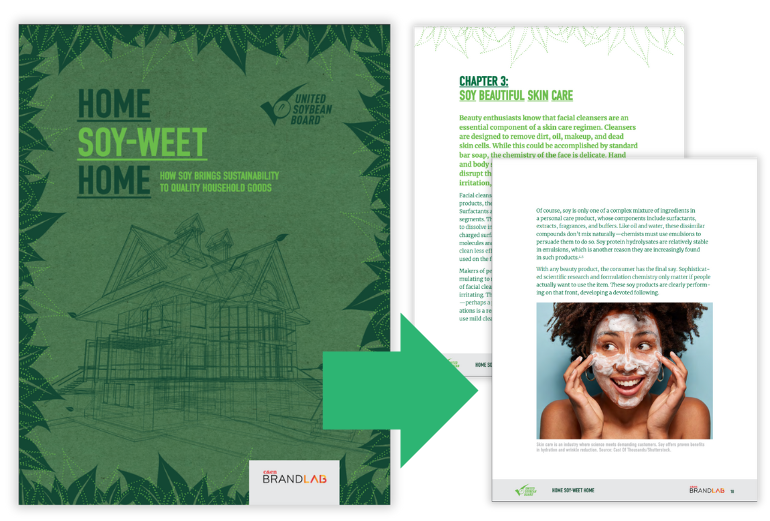Guest writer Jesse Harris is a Digital Marketing Coordinator at ACD/Labs. He has been creating internet content since 2016, and has Master’s degrees in both chemistry and chemical engineering. He loves helping STEM experts communicate their science more impactfully.
Green is the new black! As the world struggles with environmental challenges, the beauty and personal care industries have responded by moving towards sustainability. Sustainable versions of everything from hair conditioner to toenail polish are already in stores worldwide. Brand Essence Research estimates that the category will grow to over $15 billion by 2028, up from about $6.5 billion in 2021.

B2C marketers have already played a substantial role in the sustainable beauty trend, but what about B2B marketers? Do they have an opportunity to tap into this trending science topic? Absolutely. In fact, this could be a business-critical task for some companies.
This article explains the sustainable beauty trend in the personal care products industry, why it matters, and how to take advantage of it as a B2B science marketer.
Understanding Sustainability in the Personal Care and Beauty Industry
Whether it is global warming, the destruction of natural habitats, or the build-up of plastic in the oceans, the environment is under stress. The products we buy, use, and dispose of in our daily lives also impact the environment. The sustainable personal care and beauty companies address these challenges by offering eco-friendly alternatives to conventional products.
What does “environmentally friendly” mean in this case? It could include any of the following:
- Biodegradable: the product can be naturally broken down by microbes
- Biobased: the ingredients come from a biological source
- Sustainably sourced: can be naturally replenished and is not over-harvested
- Zero waste packaging: the product and container are designed to reduce waste
- Low carbon: production methods are engineered to avoid carbon emissions
- Non-toxic: does not use chemicals that are harmful to humans or the environment
While environmentally conscious consumption has existed for a while, it has taken off in the beauty industry. Why is this? There are several reasons:
Past Environmental Problems
Some high-profile ecological issues have been related to personal care products in recent memory. Microbeads found in face washes were a concern in the 2010’s, while ozone-depleting CFCs found in hairspray were a major controversy in the 1980’s.

Gen Z
Younger generations are often trendsetters for beauty and fashion. These consumers also tend to be more environmentally conscious.
A Rising Tide
The beauty industry is growing across the board. Statista estimates that total global revenue in the sector could grow to almost $750 billion in 2028, up from $550 billion in 2018.
All-Natural Marketing
Many people think that “natural” equates to “better” or “safer.” While this isn’t always scientifically accurate, it’s a common belief.
Of course, sustainability claims do not always match reality. “Greenwashing” is the practice of using deceptive marketing to overstate the environmental benefits of a good or service. Some are concerned about greenwashing in the beauty industry, which is why there have been calls from some retailers for more transparency about ingredients.
Sustainability Versus Silicones
While consumer enthusiasm for sustainable products is excellent news, the trends can sometimes get ahead of the science. Ingredients can develop a bad reputation based on exaggerations, misunderstandings, and selective interpretation of scientific data.
Take silicones, for example. Silicones are a class of chemicals used in several types of personal care products. They help hair feel clean and allow lipsticks and deodorants to apply more smoothly. These chemicals come in various structures, which are blended to achieve the desired properties for a product.
Silicones have been used for many years and have a decent safety and environmental record. However, some people have concerns that they are not biodegradable. That may sound like a serious issue, but these silicones do degrade in the natural environment, just not by biological mechanisms. While the science is nuanced, it seems most experts believe silicones do not pose a serious environmental threat.
This hasn’t stopped the European Union from banning several of the most common types of silicone. Companies are forced to reformulate their products using a mix of silicone substitutes. While this is an issue for personal care product manufacturers, it is also an opportunity for companies to sell biodegradable silicone alternatives.
B2B Marketing and Sustainable Beauty
The story of silicone is an excellent example of how marketing can play a critical role in shaping perceptions of sustainability. B2C marketers influence these perceptions through their standard tools: advertisements, partnerships, social media, packaging, and more.
But what about B2B marketers? While these standard marketing tools are still important, there is also a need to educate your audience. If consumers want sustainable products, then chemists are going to look for sustainable ingredients. However, these chemists may not know which ingredients are most environmentally friendly or how they could be used in different products. Educational eBooks, white papers, or webinars can explain how your products support sustainability, while demonstrating your company’s scientific expertise.

Want an example? An eBook, produced by C&EN BrandLab in partnership with US Soy, included a chapter on soy skincare products, exploring both the performance and environmental benefits. This type of content could be replicated for many classes of chemicals. Read the eBook here.
What about companies that are not selling chemicals? There are still opportunities to take advantage of this trend. Contract research and manufacturing in the beauty industry is competitive–promoting your company as an expert in sustainability could help differentiate your offerings. Companies that sell software used for chemical property prediction could advertise the ability to find environmentally safe and non-toxic compounds without animal testing. There are a lot of options!
Understanding Personal Care Trends for Marketers
While B2C dominates marketing our attention in the beauty and personal care industries, B2B marketing also has an opportunity. After all, the companies selling these fabulous cosmetics, skin creams, and perfumes must buy their ingredients from somewhere! B2B marketers who can tap into the growing interest in environmentally friendly beauty and personal care products can set up their companies for sustainable growth in the years to come.
Looking for help with your sustainable beauty webinar, white paper or other custom content project? Our C&EN BrandLab Team is here to help!

 Subscribe
Subscribe





